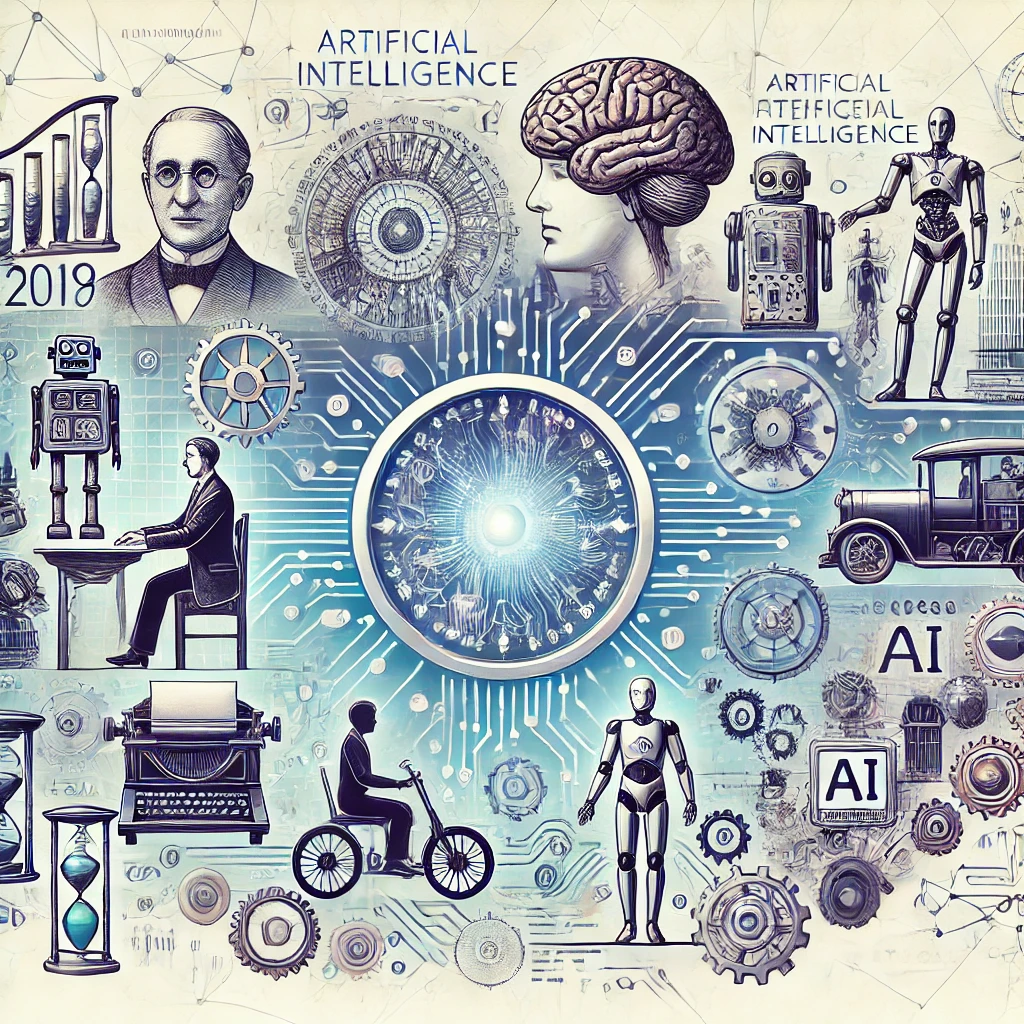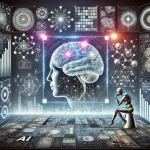The history of artificial intelligence (AI) is a fascinating journey of human ingenuity, technological breakthroughs, and continuous evolution. From its early theoretical foundations to the cutting-edge applications we see today, AI has transformed how we interact with technology, solve problems, and understand intelligence itself. This article explores the key milestones in AI development, highlighting the significant moments that have shaped the field.
The Early Foundations of AI: 1940s–1950s
The concept of artificial intelligence can be traced back to ancient myths and philosophical discussions about machines that could emulate human thought. However, the formal study of AI began in the mid-20th century, following major advancements in mathematics, logic, and computing.
One of the earliest and most significant figures in AI’s history is British mathematician and logician Alan Turing. In 1936, Turing introduced the concept of a “universal machine” capable of performing any mathematical calculation. This theoretical model laid the groundwork for the development of modern computers. In 1950, Turing published his famous paper, “Computing Machinery and Intelligence,” in which he posed the question: “Can machines think?” Turing proposed the Turing Test as a way to measure a machine’s ability to exhibit intelligent behavior indistinguishable from that of a human.
During the 1940s and 1950s, pioneers like John von Neumann and Claude Shannon made significant contributions to computing and information theory, further advancing the field of AI. By the 1950s, the idea of creating intelligent machines was gaining traction, and the stage was set for AI to emerge as a distinct discipline.
The Birth of AI as a Field: 1956
The official birth of AI as a recognized field of study is often attributed to the Dartmouth Conference held in the summer of 1956. Organized by John McCarthy, Marvin Minsky, Nathaniel Rochester, and Claude Shannon, this workshop brought together leading researchers to discuss the possibility of creating machines that could “think.” It was at this conference that McCarthy coined the term “artificial intelligence.”
The Dartmouth Conference marked the beginning of AI as a serious academic pursuit. Researchers began developing early AI programs that could solve simple problems, such as logic puzzles and games. For example, Allen Newell and Herbert A. Simon created the “Logic Theorist” in 1956, an AI program capable of proving mathematical theorems. This success demonstrated that machines could be programmed to mimic aspects of human reasoning.
The Early Successes and Setbacks: 1950s–1970s
Throughout the late 1950s and 1960s, AI research experienced several notable successes. One of the most famous AI programs from this period was “ELIZA,” developed by Joseph Weizenbaum in the 1960s. ELIZA was a simple natural language processing (NLP) program designed to simulate a psychotherapist by responding to users’ text inputs with open-ended questions. Although rudimentary by today’s standards, ELIZA showed the potential for machines to engage in conversation with humans.
In the 1970s, the AI field faced a period known as the “AI Winter,” characterized by reduced funding and waning interest. Many early AI projects had overpromised and underdelivered, leading to skepticism about the future of the field. Despite these setbacks, AI researchers continued to make incremental progress, particularly in specialized areas such as expert systems and rule-based reasoning.
The Rise of Expert Systems: 1980s
The 1980s saw the rise of expert systems, which represented a significant breakthrough in AI research. Expert systems are AI programs designed to mimic the decision-making abilities of human experts in specific domains. These systems use a knowledge base of facts and rules to reason through problems and provide solutions. One of the most famous examples is “MYCIN,” an expert system developed at Stanford University to diagnose bacterial infections and recommend treatments.
Expert systems were widely adopted in industries such as medicine, finance, and engineering, where they helped automate complex decision-making processes. This success led to renewed interest and investment in AI research during the 1980s.
The Emergence of Machine Learning: 1990s–2000s
In the 1990s, AI research began to shift its focus towards machine learning, a subset of AI that emphasizes the development of algorithms that enable machines to learn from data and improve their performance over time. Instead of relying on predefined rules, machine learning models are trained on large datasets to recognize patterns and make predictions.
One of the key milestones in AI during the 1990s was the development of reinforcement learning algorithms, which allow AI agents to learn through trial and error. This approach proved highly successful in game-playing AI systems. In 1997, IBM’s Deep Blue made history by defeating world chess champion Garry Kasparov, demonstrating the power of machine learning in strategic decision-making.
By the early 2000s, advances in computing power, data availability, and algorithm development fueled rapid progress in machine learning. AI systems became increasingly capable of performing complex tasks such as image recognition, natural language processing, and autonomous navigation. These achievements laid the groundwork for the modern era of AI.
The Deep Learning Revolution: 2010s
The 2010s witnessed a revolution in AI, driven by the rise of deep learning. Deep learning is a subset of machine learning that uses artificial neural networks to model complex relationships in data. These networks are composed of multiple layers of interconnected nodes, which allow deep learning models to process large amounts of data and make highly accurate predictions.
One of the most significant breakthroughs in deep learning occurred in 2012 when a deep neural network developed by Geoffrey Hinton and his team won the ImageNet competition, a major benchmark for image recognition. This achievement demonstrated the superiority of deep learning algorithms in tasks such as computer vision and pattern recognition.
Deep learning has since powered many of the most advanced AI applications, including self-driving cars, voice-activated virtual assistants, and facial recognition systems. Companies like Google, Facebook, and Tesla have invested heavily in deep learning research, pushing the boundaries of what AI can achieve.
Modern Achievements and Applications of AI: 2020s and Beyond
As we move into the 2020s, AI continues to make strides across various fields, from healthcare and finance to entertainment and education. One of the most prominent developments is the use of AI in natural language processing, exemplified by the creation of large-scale language models like OpenAI’s GPT series. These models have shown remarkable abilities in generating human-like text, translating languages, and answering questions.
In addition to language models, AI is making significant advancements in healthcare, where it is used for medical imaging, drug discovery, and personalized treatment recommendations. AI-driven robotics and autonomous systems are transforming industries such as manufacturing, logistics, and transportation, with self-driving cars and drones leading the way.
The growing impact of AI raises important ethical and societal questions. As AI systems become more integrated into our lives, concerns about privacy, job displacement, bias, and accountability must be addressed. Researchers and policymakers are working together to ensure that AI is developed responsibly and that its benefits are distributed equitably across society.
Conclusion
The history of artificial intelligence is a story of ambition, challenges, and remarkable achievements. From the theoretical foundations laid by visionaries like Alan Turing to the modern applications of AI in everyday life, the field has come a long way. As AI continues to evolve, its potential to revolutionize industries and improve human life grows ever more apparent. However, with these advancements come challenges that must be carefully navigated. As we look to the future, the development of AI will continue to be one of the most exciting and impactful technological journeys of our time.



what an amazing journey for AI this article shows how far it’s come, from simple computing to incredible modern capabilities
as a tech enthusiast, I’m in awe of AI’s progress
it’s exciting to think about what AI might achieve in the future
With the way things are goin…we’re all gonna be obsolete soon lol 🤣
lol, so that’s where all those weird medical gadgets came from—AI dreamed them up in the 60s
Ahahaha dats a good one bro! 😂
AI’s journey is amazing! 🤩 From Turing to today—wow! 🤖Future looks incredible. Let’s go!
promises, promises… 👎seen this before. whats really new?
lol ai history’s wild 😲😲 u know abt turing to gpt?